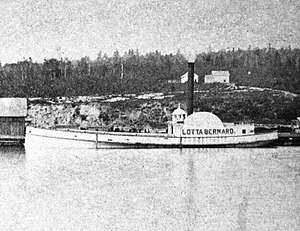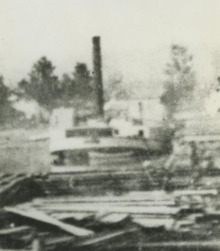PS Lotta Bernard
PS Lotta Bernard was a wooden-hulled sidewheel steam barge that served on the Great Lakes from her construction in 1869 to her sinking in 1874. On October 29, 1874 while bound from Thunder Bay, Ontario for Duluth, Minnesota, she ran into a storm which overwhelmed and sank her on Lake Superior off Encampment Island in Lake County, Minnesota with the loss of three lives. The wreck of Lotta Bernard has never been found.[3]
 Lotta Bernard before she sank | |
| History | |
|---|---|
| Name: | Lotta Bernard |
| Owner: | John D. Howard[1] |
| Port of registry: |
|
| Builder: | Lewis M. Jackson[1] |
| Launched: | September 9, 1869[1] |
| Completed: | 1869[1][2] |
| In service: | 1869[1][2] |
| Out of service: | October 29, 1874[1][2] |
| Identification: | U.S. Registry #15635[1][2] |
| Fate: | Sank on Lake Superior[2] |
| General characteristics | |
| Class and type: | Steam barge |
| Tonnage: | 147/190 gross tons[1][3] |
| Length: | 125 feet (38 m)[1][2] |
| Beam: | 24 feet (7.3 m)[1][2] |
| Depth: | 6.50 feet (1.98 m)[2] |
| Installed power: | 1 × firebox boiler[1] |
| Propulsion: | 160 hp (120 kW) crosshead steam engine[1][4] |
History
Construction

Lotta Bernard (Official number 15635) was built in 1869 by Lewis M. Jackson of Port Clinton, Ohio.[2] The master carpenter during her construction was Josh B. Davis. She was launched on September 9, 1869, and after her launch, she was fitted out in Sandusky, Ohio.[1][3] Her wooden hull was 125 feet (38 m) (one source states 117 feet (36 m)) long, 24 feet (7.3 m) wide and 6.50 feet (1.98 m) deep.[2] Sources conflict on her gross tonnage. Some sources state that she had a gross tonnage of 190 tons, other sources state that she had a gross tonnage of 147 tons.[1][5][3][6][4] She was equipped with a 160 hp (120 kW) crosshead steam engine[4] with a piston with 22 inch (56 cm) bore and a 60 inch (150 cm) stroke, which was built by Klotz & Kramer of Sandusky, and was connected to the ship's paddle wheels via a 7 foot (2.1 m) wrought iron shaft. Steam for the engine was provided by a single 6.4 foot (2.0 m) × 16 foot (4.9 m) firebox boiler. Lotta Bernard was driven by two paddle wheels with a diameter of 19 feet (5.8 m) and a width of 4.5 feet (1.4 m).[1] Her top speed was 4 miles per hour (3.5 kn), which was considered too slow for the type of work she was used for. She was what was called a "rabbit" type steamer, which meant that all her cabins were located at the stern, and her forward decks were left open.[3]
Service History
Lotta Bernard was built for S.W. Dorsey of Sandusky, and was named after his business partner's daughter, and his own son.[3] When she entered service on November 5, 1869, she was chartered by the Northern Transportation Company to carry cordwood from the Portage River and Put-in-Bay to Cleveland, Ohio to be used in ship construction.[1][7]
In 1870 she was sold to Luman H. Tenney of Duluth, Minnesota.[5] Under Tenney's ownership, she was contracted to haul building materials from Bark Bay, Wisconsin to Duluth to be used in the construction of the first grain elevator.[1]
In 1871 she was sold to John D. Howard of Superior, Wisconsin, and she was officially registered in Superior.[4][1] On November 17, 1871 Lotta Bernard was torn from a dock in Grand Marais, Minnesota and was blown ashore, sustaining damage to her hull, rudder, paddlewheels and her boiler. She was eventually refloated and taken to Duluth for repairs.[1] On November 28, 1872 while carrying a cargo of flour, feed and grain, Lotta Bernard broke her rudder chains in a snowstorm and beached near Ontonagon, Michigan. She was released for repairs in April/May 1873.[1][6]
Final voyage
On October 29, 1874 Lotta Bernard left Thunder Bay, Ontario under the command of Captain Michael Norris, with a cargo consisting of a horse 200 sacks of flour and 60 kegs of fish; there were 13 crew members (including Captain Norris) and 2 passengers also on board.[3] As she neared Encampment Island, she began to encounter a storm, and began taking water over the stern. As the huge waves pounded her hull, they began to smash her cabins apart, eventually leaving only the smokestack standing. Captain Norris ordered the pumps started, to try to empty the water flowing into her hull. He also ordered Lotta Bernard's bow anchor dropped, in order to swing her into the seas, but she continued to sink.[3] Eventually, the situation got so bad, that Captain Norris ordered the crew to launch the lifeboats. One of the lifeboats which contained eight people was swamped by a wave while it was still next to the ship. Two of the people who were in the lifeboat drowned when it capsized, while the remaining six managed to make it to the other lifeboat. The survivors eventually reached land near Silver Creek, Minnesota, where Captain Norris split the 13 survivors into two groups in order to find shelter. The group of ten found a local Ojibwe camp, where they received shelter, food and got a chance to dry their soaked clothes.[6] Meanwhile, the other group of three found the other lifeboat washed up on the shore. One of the group of three eventually died of exposure.[3][1] After the storm had, passed the twelve remaining survivors decided to row back to Duluth. They encountered a fishing camp near Two Harbors, Minnesota, where they received food and got a chance to get warm. Afterwards, they rowed the remaining 33 miles back to Duluth. All of them made it unharmed. Although Lotta Bernard was valued at $20,000, she was only insured for $10,000.[4][3]
The schooner Vanguard found Lotta Bernard's pilothouse off Outer Island.[8]
Lotta Bernard wreck
As of 2020 the wreck of Lotta Bernard has not been found. The Great Lakes Shipwreck Preservation Society had plans to try and locate her; they had planned to search for her on June 27-28, and if not found, they planned to search for her on September 12-13. Both of the expeditions have since been cancelled in light of the COVID-19 pandemic.[9]
References
| Wikimedia Commons has media related to Lotta Bernard (ship, 1869). |
- "Lotta Bernard". Alpena County George N. Fletcher Public Library. Retrieved May 7, 2020.
- "Lotta Bernard". Bowling Green State University. Retrieved May 7, 2020.
- Daniel, Stephen B. (2008). Shipwrecks Along Lake Superior's North Shore: A Diver's Guide. Minnesota Historical Society. pp. 81–82. ISBN 9780873516181.
- "Lotta Bernard (Steamboat), U15635, sunk, 30 Oct 1874". Maritime History of the Great Lakes. Retrieved May 7, 2020.
- "Lotta Bernard PSS (+1874)". Wrecksite. Retrieved May 7, 2020.
- "October 29, 1874: The sidewheeler Lotta Bernard wrecks on Lake Superior". Zenith City Press. Retrieved May 7, 2020.
- "Lotta Bernard". WorldCat. Retrieved May 8, 2020.
- "Vanguard". Alpena County George N. Fletcher Public Library. Retrieved May 8, 2020.
- "2020 Projects / Programs Schedule". Great Lakes Shipwreck Preservation Society. Retrieved May 7, 2020.